Wet-Fired, the Eighth Biennale of Israeli Ceramics, places the focus on the material itself and the relationship of the artist to the material in the artistic process. Curated by Dr. Eran Erlich, Head of the Ceramic and Glass Design Department at the Bezalel Academy of Art and Design, Jerusalem, the exhibition will open at the Eretz Israel Museum on August 1, 2016. The exhibition reveals a richly diverse and visually exciting proliferation of works by contemporary Israeli ceramic artists, working with different ceramic materials, techniques, and with dramatically individual approaches to their art.
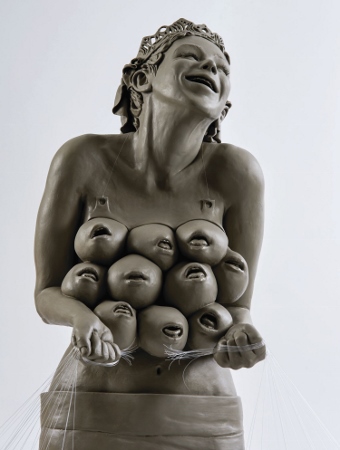
“I wanted to develop a conscious mode of thinking about ceramics,” Curator Dr. Eran Erlich said during a preview tour of the exhibition, explaining that the intention is not only to focus on the physical aspects of the material, but involves an awareness that the ceramic material incorporates “references to history, gender, ways of working and a different approach to life derived from the process of working with the material. The craft pulls in a direction subversive to industrial age understanding, the material suggests new ways of thinking about terms such as ‘efficiency’ and ‘effectiveness.’ The logic of efficiency, the capitalist thinking of the 19th and 20th centuries influences our thought in art. In this post-modern world there is an interesting relevance to the return of things that had been marginalized and now return to center stage.”
“Ceramics preserves aspects of the human experience that are eliminated by many mediums,” Erlich said, adding that in our contemporary environment, “everything is directed to the image, everything is translated into two dimensions – video, photography – the two dimensional world and not the material world…I call ceramics the preserver of lost senses.”
Noting that ceramics is not only tactile, but embodies sound and scent in different ways, Erlich said that ceramics “invites us to a more whole experience and creates a place for senses other than sight, which today has become the dominant sense. We see everything through flat dimensions and ceramics offers something different… I call it the underminer of the dictatorship of the intellect. The material brings us a sensual experience as an alternative to intellectual understanding, and we can experience the world in a more complex, rich way through our senses.”
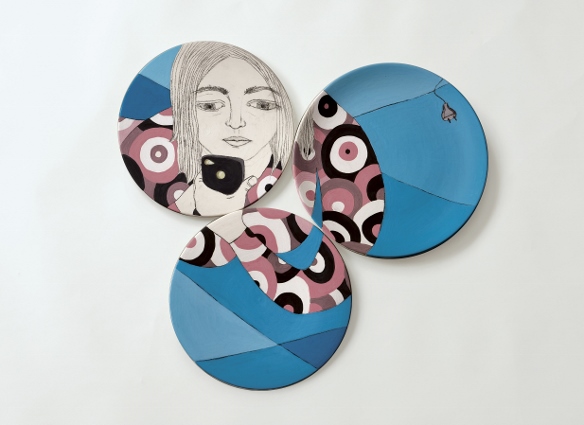
The exhibition doors open onto Galia Armeland’s The Tidings – a playful exploration of the artist’s environment, creating a lively visual narrative that references the digital dimension of contemporary life, amid the textures, colors, history of person and place, craft, art and nature.
Reut Iron’s excellent exhibition design creates intriguing paths and alternative routes through the exhibition. The multitude of visions and associations suggests that one plan to spend some time discovering the different works. In the two- year process of developing the exhibition, Erlich along with his assistant Tamar Lerner, visited the artists’ studios, and established an artistic dialogue exploring the themes. Accompanying each work in the exhibit is a statement by the artist reflecting on the relationship and approach to ceramics.
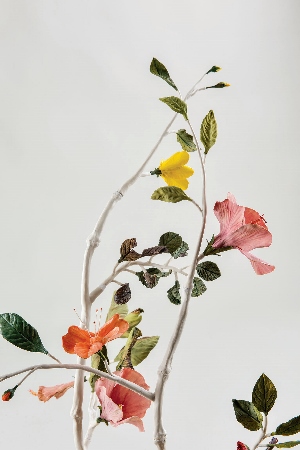
In the artist’s note accompanying her work Don’t Touch Me, Avital Eshed Avital refers to porcelain as the “wild horse of ceramic material” saying she has “no pretension of taming it.” Yet the delicate details and colorful blossoms reveal a breath-taking sensitivity as well as a wild beauty.
In contrast, just adjacent to Avital’s piece is a video of Esther Beck taking on a herculean task: the shaping of four and a half tons of stoneware. Sitting within the wet clay structure, stomping on it with her boots, pushing at it with a sledge hammer – the interaction with the material is fascinating.
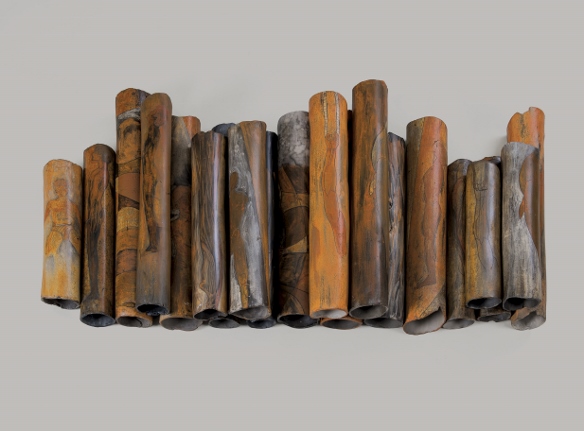
Shamai Gibsh’s Sealed Smoke employs terra sigillata, a contemporary recreation of methods gleaned from red hued Roman pottery with a burnished surface slip. Clay is mixed into a fine liquid slip which is used to cover the completed, unfired, vessel and then polished with a cloth to create a smooth, glossy, finish. This lustrous finish can be retained after firing at the appropriate temperatures. Sealed Smoke suggests an alluring forest where figures wander with their secrets, textures, and desires.
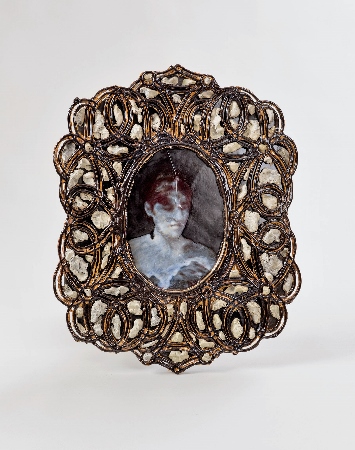
In Fundamental Attribution Error Efrat Eyal references the work of English photographer Eadweard Muybridge known for his photographic studies of motion (link to images on the MOMA site). Eyal calls attention to a glaring omission on the part of the photographer, and rectifies it in her project. Muybridge photographed scores of women for his motion studies, yet these women remained anonymous, unknown. In this work Eyal takes the portrait of each woman, creating it as part of an ornate frame, exhibited in a place of honor on the wall. Thus giving them the respect, attention and appreciation they are due.
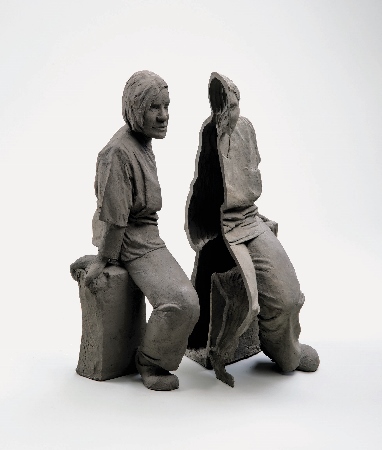
Noa Arad-Yairi’s Splittings are figurative portraits of women that have been split to reveal the work within, the traces of the artistic process. Ronit Baranga’s My Artemis is a fantastic vision realized with artistic precision that sends the imagination soaring in several different directions. Barak Twito’s Dolls Figurines includes figures that in their form reference the ancient female nude statuettes carved of stone or fired clay (the latter are the oldest known ceramic art, such as the Venus of Dolní Věstonice dated to 29,000–25,000 BCE) alongside other images, including the contemporary infamous ubiquitous commercial doll.
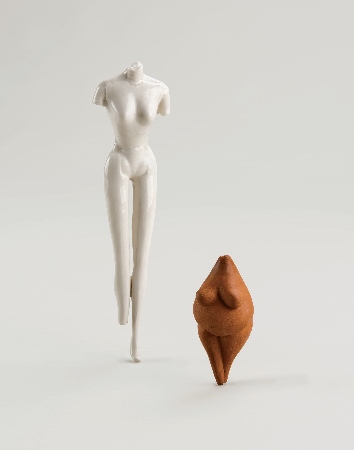
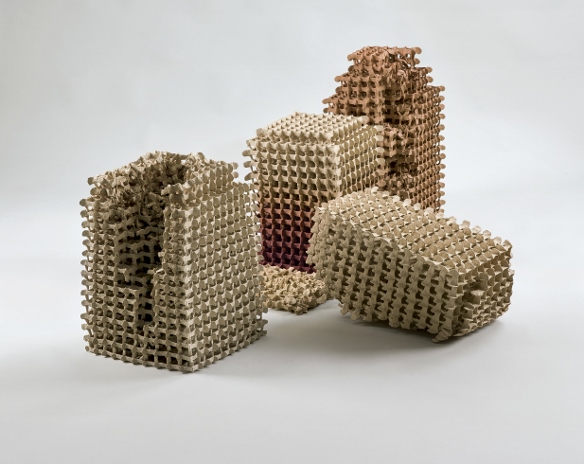
Gilla Miller Lapidot’s Creates Worlds and Destroys Them is a powerful work that can be viewed as a sad commentary on our contemporary situation. Boris Katz’s Head is a playful reference to the artist Arcimboldo, and can also literally be played – the individual vessels that make up this work are actually clay flutes!
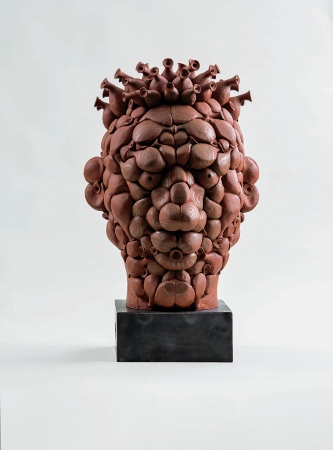
Wet-Fired, The Eighth Biennale of Israeli Ceramics will open on August 1, 2016 at the Eretz Israel Museum. Opening hours and additional information may be found on the museum website. During the month of August, there will be extended visiting hours on Tuesdays and Thursdays from 10:00 – 22:00.





